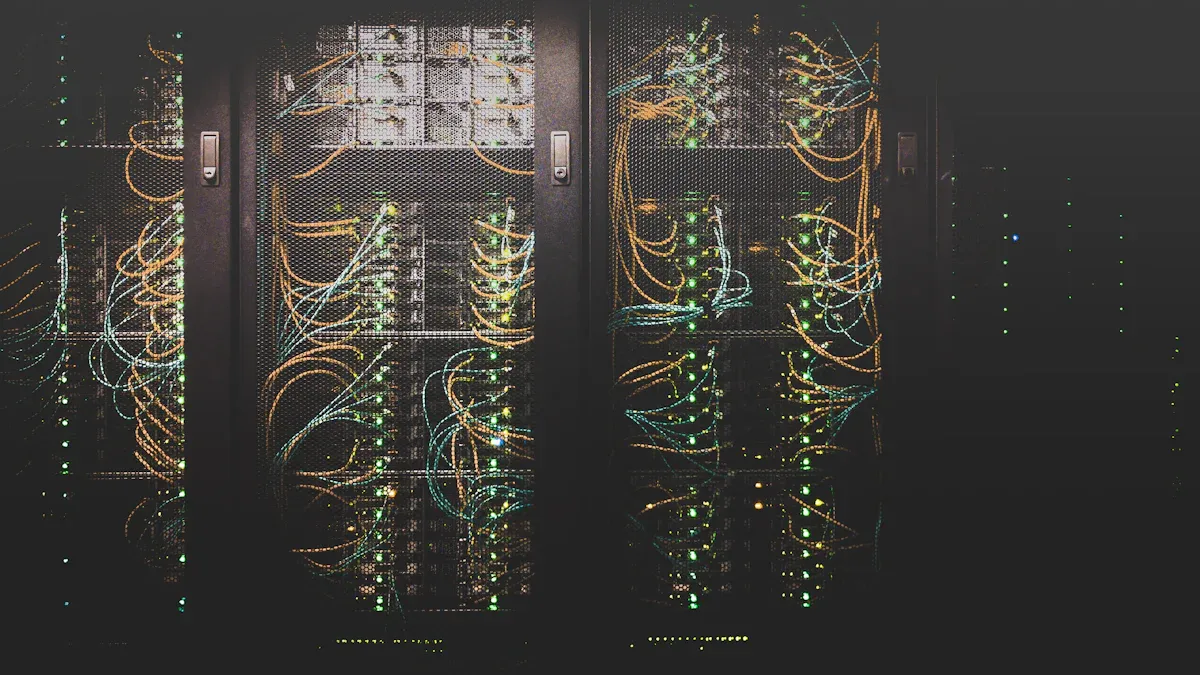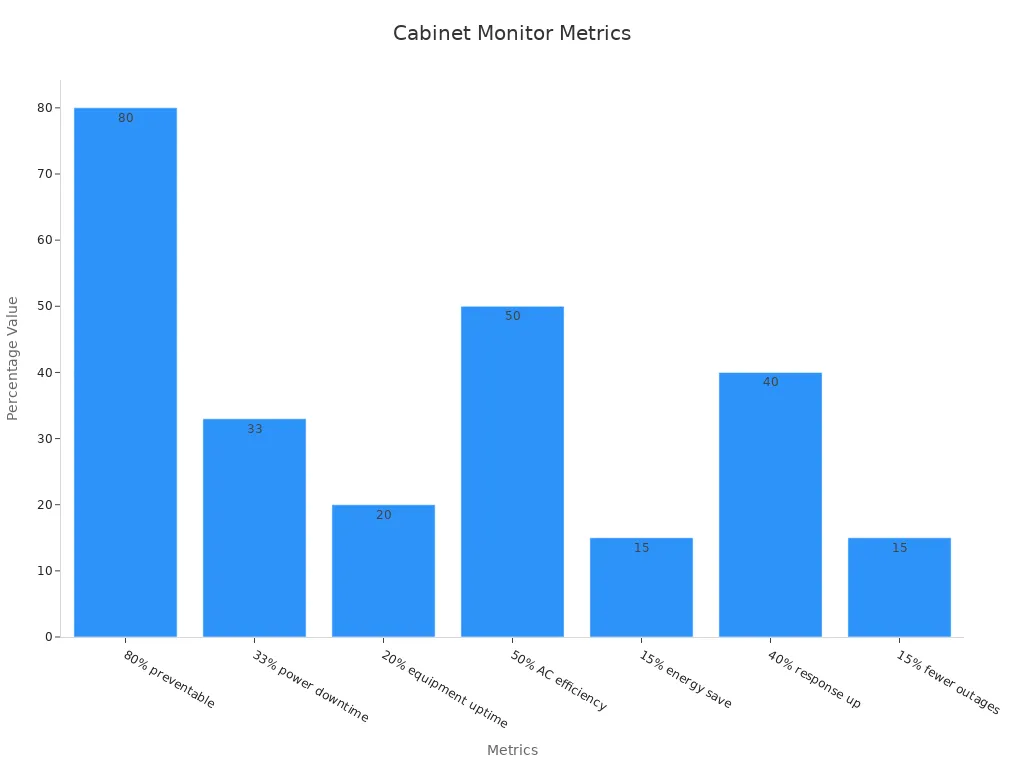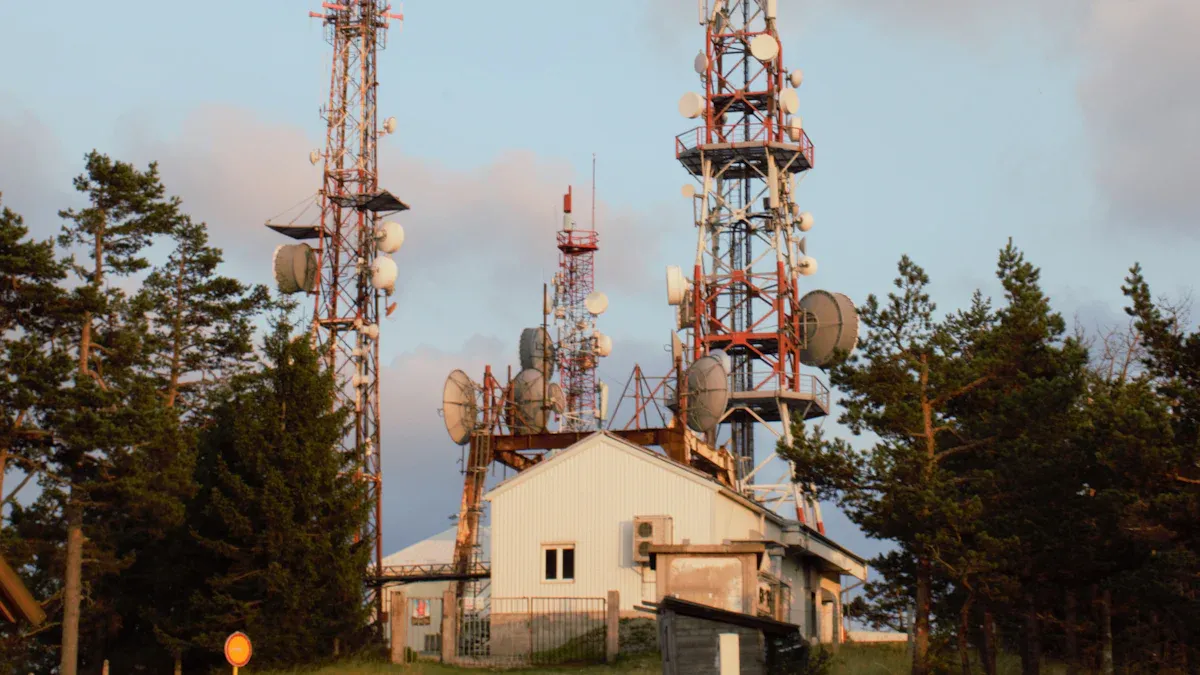Real-time remote monitoring for telecom cabinets

You face increasing pressure to keep telecom cabinets running without interruption. Real-time remote monitoring lets you spot critical issues—like temperature spikes, humidity changes, and security breaches—before they escalate. ESTEL’s solutions have proven reliable, with over 2.4 million rectifier modules installed globally. Early detection can reduce battery failure rates by up to 98% and prevent costly outages, which have caused some operators losses exceeding $6 million.
Preventing downtime not only protects equipment but also saves significant operational costs. Upgrading to advanced, IoT-enabled monitoring systems ensures you stay ahead of potential failures.
Key Takeaways
Real-time remote monitoring helps detect problems early, preventing downtime and costly equipment failures.
Using intelligent sensors and power units improves energy efficiency and reduces maintenance visits, saving money.
Monitoring environmental factors like temperature and humidity protects equipment and extends its life.
Centralized platforms and IoT connectivity give you full control and quick alerts to manage your telecom cabinets effectively.
Proactive maintenance based on real-time data lowers repair times and boosts network reliability.
Why Monitoring Matters
Uptime and Reliability
You depend on your telecom cabinets to deliver uninterrupted service. Even a short outage can disrupt thousands of users and damage your reputation. Research shows that 80% of recent telecom outages could have been prevented with proactive measures enabled by continuous monitoring systems. Power outages cause 33% of downtime incidents, making power independence and real-time environmental monitoring essential. AI-driven predictive analytics can anticipate equipment failures weeks in advance, giving you time to schedule maintenance and avoid disruptions.
Remote monitoring services improve maintenance response times by 40%, ensuring you resolve issues quickly. Facilities with backup power configurations see a 25% increase in operational reliability. Advanced Power Distribution Units (PDUs) provide real-time monitoring of power consumption, helping you prevent overloads and downtime.
Metric / Research Finding | Description / Impact |
|---|---|
80% of recent outages were preventable | Proactive monitoring and ESTEL PDUs enable early detection and prevention of outages, reducing downtime significantly. |
33% of downtime caused by power outages | Highlights the need for power independence and continuous monitoring to maintain uptime during outages. |
AI-driven predictive analytics anticipate failures weeks in advance | Enables predictive maintenance, reducing unexpected disruptions and improving network reliability. |
20% improvement in equipment uptime | Case study from a telecommunications company using intelligent PDUs shows significant uptime gains and maintenance cost reduction. |

Cost Reduction
You can achieve significant cost savings by adopting real-time remote monitoring. Intelligent PDUs and environmental sensors help you detect issues early, reducing the need for emergency repairs and site visits. Data shows that advanced cooling and ventilation systems, when monitored continuously, can cut air conditioner power consumption by over 50%. Energy efficiency metrics like Power Usage Effectiveness (PUE) and Energy Savings Rate (ESR) improve as you optimize power use and reduce waste. These improvements support both your operational budget and sustainability goals.
Early detection of problems such as intrusion, smoke, or water leaks prevents unexpected downtime.
Differentiated power alarms allow you to identify internal versus external power issues, reducing unnecessary maintenance trips.
Real-time alerts and historical trend tracking enable you to plan maintenance, extend equipment life, and avoid catastrophic failures.
5G and Modern Networks
The shift to 5G and distributed networks increases the complexity of your infrastructure. You must handle high data rates, real-time data processing, and enhanced security with minimal delay. Integrating technologies like cloud computing, SDN, and NFV requires dynamic control and centralized network provisioning. This complexity makes comprehensive monitoring systems more important than ever.
A systematic review highlights that 5G networks support massive machine-to-machine communications, ultra-reliable low latency communications, and enhanced mobile broadband. These features demand real-time management and secure connectivity. Real-time remote monitoring gives you the oversight needed to manage latency, bandwidth, security, and device connectivity in these advanced environments.
Monitoring Needs
Environmental Factors
You must monitor environmental conditions inside telecom cabinets to ensure equipment longevity and reliability. Key parameters include temperature, humidity, and airflow.
Temperature sensors help you prevent overheating, which can degrade batteries and reduce efficiency.
Humidity sensors keep levels around 60% relative humidity, avoiding condensation and corrosion.
Airflow management stops hotspots and supports efficient cooling.
Sensors provide real-time data, enabling you to respond quickly to environmental changes.
Environmental sensors, such as those from ESTEL, offer precise measurements of temperature, dew point, and relative humidity. These sensors allow you to map conditions inside cabinets and detect changes that could impact performance. Following ASHRAE guidelines, you can maintain optimal dew point and humidity levels, reducing risks of equipment failure.
Vendor | Sensor Model | Key Features and Accuracy |
|---|---|---|
AVTECH | Digital Temperature & Humidity Sensor | Real-time monitoring of temperature (-40 to 85°C), humidity, heat index, and dew point. |
Packet Power | E302 Environmental Monitoring Sensor | Combines dew point and up to 6 temperature points per monitor, enabling 3D mapping of temperature and humidity. |
Power and Energy
You need to track power consumption and energy use to prevent failures and optimize efficiency. Intelligent PDUs and energy sensors detect anomalies early, helping you avoid overloads and downtime.
Real-time monitoring provides detailed power usage metrics, allowing you to spot trends and act before problems escalate.
Load balancing ensures even power distribution, reducing the risk of outages.
Threshold alerts notify you before reaching critical power levels, so you can intervene proactively.
Metric | Improvement Description |
|---|---|
Annual reduction by 0.013–0.018, showing better efficiency. | |
Cooling System Energy Consumption | Reduced by 5.8%, lowering costs and overheating risks. |
Annual Electricity Cost Savings | Up to 21% decrease, supporting your operational budget. |
ESTEL sensors integrate with your monitoring platform, giving you the insights needed to manage energy use and improve cabinet reliability.
Security and Access
Protecting your telecom cabinets from unauthorized access is essential. You can deploy motion-activated cameras and sensors to detect movement and trigger alarms.
Advanced locking mechanisms, such as biometric and electronic locks, restrict access to authorized personnel only.
Integration with centralized monitoring systems provides real-time alerts and audit trails for every access event.
Regular security audits and staff training further strengthen your security framework.
These combined measures, supported by ESTEL’s comprehensive monitoring solutions, help you reduce risks of intrusion and vandalism, ensuring your network remains secure.
Real-time Remote Monitoring Solutions

IoT and Connectivity
You need robust connectivity to ensure your telecom cabinets operate efficiently. IoT-enabled systems transform your monitoring approach by connecting sensors, controllers, and devices across your network. These systems collect real-time data on temperature, humidity, power, and security, giving you instant visibility into every cabinet.
IoT sensors, such as RFID and GPS, enable continuous tracking of assets and environmental conditions. You receive live updates on equipment status, which helps you respond quickly to changes.
Secure communication protocols, encryption, and multi-factor authentication protect your data as it moves across the network.
Open connectivity standards and collaboration between vendors ensure seamless integration and data exchange.
Real-time alerts from IoT data allow you to act immediately when issues arise, improving reliability and reducing downtime.
Telecom providers use IoT integration with 5G networks to deliver high-speed, low-latency connections, which are essential for real-time remote monitoring.
Smart city projects and industrial monitoring offer strong examples. Traffic flow sensors and intelligent streetlights use IoT to adjust operations in real time. In telecom, you benefit from similar technology by tracking cabinet conditions and predicting failures before they happen. Cloud-based IoT management platforms centralize your data, making it easy to analyze trends and optimize performance.
Centralized Platforms
Centralized platforms bring all your monitoring data together in one place. You can manage multiple sensor types—temperature, humidity, airflow, and security—from a single dashboard. This unified view streamlines your operations and supports proactive maintenance.
ESTEL’s sensor portfolio integrates temperature, humidity, airflow, and contact closure sensors within your telecom cabinets. You gain comprehensive environmental and security monitoring.
Multisensors combine several technologies into one device, simplifying installation and providing holistic data streams for fault detection and energy management.
Platforms like Raritan’s Smart Rack Controller (SRC) collect and manage data from diverse sensors, including vibration and asset tracking. You can integrate these solutions with your existing infrastructure without major changes.
Features such as API access, SNMP support, and compatibility with DCIM tools allow you to customize your monitoring system and connect with other IT management platforms.
Centralized platforms support real-time remote monitoring by providing instant alerts, remote configuration, and detailed analytics. You can visualize trends, generate reports, and make informed decisions to improve reliability and reduce costs.
Alerts and Reports
Real-time alerts and detailed reports are critical for effective telecom cabinet management. You receive immediate notifications when sensors detect abnormal conditions, allowing you to respond before problems escalate.
Feature/Metric | Description/Impact on Response Time and Performance |
|---|---|
Real-time alerting | Enables immediate detection of issues, improving response times |
Auto ticketing and alarms | Automates incident reporting, reducing manual delays |
Embedded analytics | Provides insights to detect flawed asset patterns, supporting proactive maintenance |
KPI tracking | Improves operational performance by monitoring key metrics in real time |
Remote management | Ensures 100% reliable visibility and control over assets |
Benefits | Reduced repair and emergency maintenance costs, extended asset life, improved productivity |
You can automate incident reporting and ticketing, which reduces manual work and speeds up your response. Embedded analytics help you spot patterns and predict failures, so you can schedule maintenance before issues cause downtime. KPI dashboards and NOC activity reports give you a clear view of your network’s health.
Remote management tools let you troubleshoot and resolve issues without sending technicians on-site. This approach lowers maintenance costs and extends the life of your equipment. Real-time remote monitoring ensures you always have up-to-date information, supporting data-driven decisions and continual service improvement.
Tip: Integrate your monitoring platform with both RTUs and mobile or desktop applications. This setup gives you flexible access to real-time data and alerts, whether you are in the office or on the move.
Implementation Steps
Assess Requirements
Start by evaluating your telecom sites. Identify the number of cabinets, their locations, and the environmental risks each site faces. List the equipment inside each cabinet and note their power and cooling needs. Review your current monitoring capabilities and highlight any gaps. You should also consider your network’s growth plans to ensure your monitoring solution can scale with future expansions.
Tip: Involve both IT and facilities teams during this assessment. Their combined expertise helps you capture all operational and technical requirements.
Sensor Integration
Select sensors that match your site’s needs. Choose temperature, humidity, airflow, and power sensors that offer high accuracy and reliability. Look for modular PDUs that support easy upgrades and additional sensor connections. ESTEL’s PDU Model 1 works well for small to medium cabinets, providing real-time monitoring, overload protection, and energy efficiency. For larger operations, ESTEL PDU Model 2 delivers remote management, alarm systems, and environmental sensors built for harsh conditions.
Modular PDU designs let you add outlets and features as your needs grow.
Intelligent PDUs with IoT and AI-driven systems enhance operational reliability and energy efficiency.
Integration with RTUs ensures seamless data collection and remote control.
Setup and Scalability
Install your sensors and PDUs according to manufacturer guidelines. Connect them to a centralized monitoring platform for unified oversight. Use platforms that support open protocols and API integration to avoid vendor lock-in. This approach allows you to add new devices or switch vendors without major disruptions.
A telecom provider in Australia used Branch Circuit Monitors for precise energy tracking and troubleshooting.
Another company improved equipment uptime by 20% by matching PDU capacity to equipment needs.
Leading data centers in Asia adopted modular and smart PDUs, achieving up to 15% better energy efficiency and supporting green initiatives.
Plan for future growth by choosing scalable solutions. Modular hardware and open software interfaces make it easy to expand your monitoring system as your network evolves.
Note: Prioritize solutions that offer remote firmware updates and flexible licensing. These features help you adapt to new technologies and changing business needs.
Proactive Benefits

Early Alerts
You gain a significant advantage when you receive early alerts from your monitoring system. Real-time remote monitoring detects abnormal conditions—such as temperature spikes, humidity changes, or unauthorized access—before they become critical. Automated incident categorization and AI-driven anomaly detection speed up your response and reduce manual triage. The table below highlights the impact of these features:
Feature | Impact |
|---|---|
Automated Incident Categorization | Speeds up initial response by reducing manual triage by 58%. |
AI-driven Anomaly Detection | Enhances early detection and predictive capabilities in 65% of deployments. |
Mean Time to Repair (MTTR) | Cuts MTTR from 4.8 hours to 3.1 hours, enabling faster incident resolution. |
Real-time Drone Feeds | Improves resource deployment by 18% and reduces response time by 30 minutes during crises. |
ESTEL sensors monitor temperature, humidity, power, and access 24/7. Immediate alerts allow you to intervene quickly, preventing equipment failures and minimizing costly downtime.
Maintenance Optimization
You can optimize your maintenance strategy by relying on continuous data from your monitoring system. Predictive maintenance becomes possible when you use real-time alerts and historical trends. This approach reduces unplanned downtime and shortens repair times. You avoid unnecessary site visits and focus your resources where they matter most.
Immediate alerts from sensors enable rapid intervention.
Remote management and AI-driven detection improve early identification of issues.
Predictive maintenance reduces mean time to repair and extends equipment life.
Industry statistics show that proactive monitoring can cut maintenance costs by up to 25% and improve operational efficiency by 30%. You keep your network running smoothly and reduce emergency repairs.
Data-driven Decisions
You make better decisions when you have access to accurate, real-time data. Telecom networks generate massive amounts of information every day. Next-generation analytics tools process this data and provide actionable insights. You can identify trends, correlate events, and receive recommendations for network improvements.
Metric | Before Implementation | After Implementation | Improvement |
|---|---|---|---|
Operational Efficiency | 60% | 90% | 30% Increase |
Cost Reduction | N/A | N/A | 25% Savings |
Customer Retention | 70% | 90% | 20% Increase |
Data Accuracy | 65% | 95% | 35% Improvement |
With real-time remote monitoring, you enhance customer satisfaction, reduce costs, and drive revenue growth. Data-driven insights help you make informed choices, ensuring your telecom cabinets support your business goals.
You gain clear advantages by adopting advanced monitoring solutions for your telecom cabinets.
Early detection of issues prevents service disruptions and reduces downtime.
Remote power management cuts unnecessary site visits, saving costs.
Flexible alert systems and scalable tools support long-term efficiency.
Outsourced monitoring partners provide expertise and continuous oversight, improving uptime.
Consider consulting with solution providers or conducting a needs assessment to ensure your network stays reliable and cost-effective.
FAQ
What parameters should you monitor in a telecom cabinet?
You should monitor temperature, humidity, airflow, power consumption, battery status, and cabinet access. These parameters help you prevent equipment failures and security breaches.
How does real-time monitoring reduce maintenance costs?
Real-time monitoring alerts you to issues early. You can schedule repairs before failures occur. This approach reduces emergency site visits and extends equipment life.
Can you integrate remote monitoring with existing systems?
Yes. Most modern solutions support open protocols and APIs. You can connect new sensors and platforms to your current infrastructure without major changes.
What happens if a sensor detects a critical issue?
You receive instant alerts by email, SMS, or app notification. The system can trigger alarms, open support tickets, or even shut down equipment to prevent damage.
Is remote monitoring secure?
You benefit from encrypted data transmission and multi-factor authentication. Regular software updates and strict access controls protect your network from unauthorized access.
See Also
Best Practices For Monitoring Outdoor Telecom Equipment Cabinets
A Comprehensive Guide To The Functions Of Telecom Cabinets
Exploring The Importance Of Outdoor Cabinets In Telecom Networks
Effective Methods To Safeguard Equipment Using Outdoor Cabinets
Strategies To Maintain Consistent Power For Telecom Cabinets
CALL US DIRECTLY
86-13752765943
3A-8, SHUIWAN 1979 SQUARE (PHASE II), NO.111, TAIZI ROAD,SHUIWAN COMMUNITY, ZHAOSHANG STREET, NANSHAN DISTRICT, SHENZHEN, GUANGDONG, CHINA

